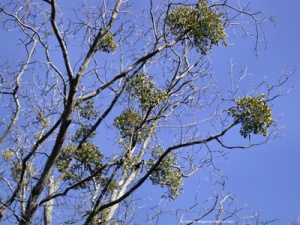Viscum album
| See Also | Botanical Monographs |
|---|
Mistletoe (Viscum album) was historically known for its use with epilepsy and other convulsive nervous disorders, but it now more commonly known for its use in cardiovascular conditions and cancer treatments. To explore the characteristics, medicinal uses and prescribing considerations of this herb in more detail, check out the references indicated.[1], [2]
Contents
Characteristics
AKA V. flavescens, Loranthus europaeus
- Common Names: Mistletoe
- Family: Loranthaceae
- Habitat: Viscum album is native to Europe and North America.
- Parts Used: Whole plant, in November, oak host preferred, elm acceptable; effect is lost if kept >1 year (45% alcohol)
- Constituents: cardioprotective polypeptide carbohydrates (tyramine), oleanolic acids, histamine, alkaloids
- Medicinal Actions: cerebral circulatory stimulant, hypotensive, tumour inhibition (injection), antispasmodic, cardiac tonic, nervine, sedative
Uses
Historical Uses:
Mistletoe was used historically in Old Europe for treatment of epilepsy and other convulsive nervous disorders, and was used extensively in the 16th and 17th centuries. Mistletoe is a nervine and a narcotic that has a profound effect on the nervous system. Eating the berries can cause convulsion in children.
Medicinal Uses:
- used primarily with difficult to treat cancers such as ovarian cancer, leiomas, sarcomas
- Tumour inhibition is due to special protein or lectin, not cytotoxic
- Does not need to be injected near the tumour, can be injected in the abdomen like insulin (subcutaneously)
- Injections appear to be safe in pregnancy and lactation [2]
- hypertension with headache, vertigo, decreased energy, irritability from elevated blood pressure, moderate to mildly severe hypertension (160/100); well tolerated long term, but generally used to get hypertension down and transfer to another herb
- heart conditions with weak, irregular heart with hypertrophy, shortness of breath, valvular insufficiency, nervous tachycardia, nervousness with inability to lie down due to heart symptoms
- Other Conditions
- pains which are tearing, neuralgic or rheumatic, osteoarthritis
- epilepsy, congestive headache, insomnia
- anxiety, panic attacks, hysteria, flushed face
Prescribing Considerations
The information provided is intended to augment the treatment from a naturopathic doctor or other trained medical professional. Although most herbs are generally safe, it is recommended that you avoid self-prescribing especially when there is an underlying ongoing medical condition, if you are on any prescription medications or if you are pregnant or breastfeeding.
Formulations and Preparation
- Tincture - 30-60 drops three times daily (more than this can create hypertension)
- Fluid extract - 25-60 drops
- Infusion - 2.5g infused in cold water for 10-12 hours, twice daily
Safety
The safety and prescribing considerations for this herb include:[3] [4]
- Generally regarded as safe. 1-2 berries is fatal in a child (white berries are extremely poisonous).
- Side-effects are generally not seen.
- Caution in pregnancy because the tyramine in the herb is a uterine stimulant. Also caution with migraine headaches.
- Iscador is a derivative of Viscum album used in the treatment of cancer alongside conventional treatments.
- Contraindicated in fever, intracranial and intraspinal tumour, increased risk of hypertension in pregnancy, and known allergy
- Drug-Herb Interactions.[2]
- Monoamine Inhibitor Antidepressants - Use caution because of the tyramine content in the herb.
References
- ↑ Boon Heather, Smith Michael (2009) 55 Most Common Medicinal Herbs: The Complete Natural Medicine Guide Second Edition Institute of Naturopathic Education and Research, CCNM Toronto.
- ↑ 2.0 2.1 2.2 Godfrey Anthony, Saunders Paul, Barlow Kerry, Gowan Matt (2011) Principles and Practices of Naturopathic Botanical Medicine, Advanced Botanical Medicine. V3 CCNM Press, Toronto.
- ↑ Stargrove Mitchell Bebell, Treasure Jonathan, McKee Dwight L (2008) Herb, Nutrient and Drug Interactions: Clinical Implications and Therapeutic Strategies.
- ↑ Brinker Francis (1997) Herbal Contraindications and Drug Interactions: Plus Herbal Adjuncts With Medicines, 4th Edition Eclectic Medical Publications.
